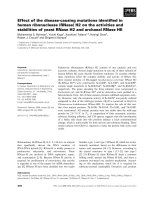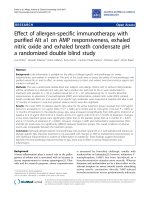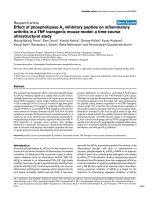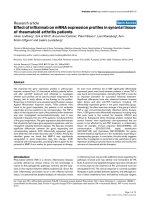Báo cáo y học: "Effect of antibodies on the expression of Plasmodium falciparum circumsporozoite protein gene"
Bạn đang xem bản rút gọn của tài liệu. Xem và tải ngay bản đầy đủ của tài liệu tại đây (313.91 KB, 4 trang )
Int. J. Med. Sci. 2006, 3
7
International Journal of Medical Sciences
ISSN 1449-1907 www.medsci.org 2006 3(1):7-10
©2006 Ivyspring International Publisher. All rights reserved
Research paper
Effect of antibodies on the expression of Plasmodium falciparum circumsporozoite
protein gene
B S Jesuíno, C Casimiro, V E do Rosário and H Silveira
Centro de Malária e Outras Doenças Tropicais, UEI Malária, Instituto de Higiene e Medicina Tropical, Universidade Nova de
Lisboa, Rua da Junqueira, 96, 1349-008 Lisbon, Portugal
Corresponding address: Henrique Silveira, e-mail: Tel: +351 21 3652657 Fax: +351 21 3622458
Received: 2005.10.05; Accepted: 2005.12.18; Published: 2006.01.01
Antibodies are known to play an important role in the control of malaria infection. However, they can modulate
parasite development enhancing infection. The effect of anti-Plasmodium antibodies on the expression of
circumsporozoite protein gene (csp) was investigated. Plasmodium falciparum 3D7 in vitro cultures were submitted to: i)
anti- circumsporozoite protein monoclonal antibody (anti-CSP-mAb) [1μg/ml, 0.1μg/ml, 0.01μg/ml and 0.001μg/ml]
and ii) purified IgG Fab fragment from a pool of malaria patients [1mg/ml and 1μg/ml]; and compared to control
cultures. After 24h the number of ring infected erythrocytes was determined in order to calculate invasion efficacy. At
48h culture supernatant was collected, and the amount of circumsporozoite protein determined by ELISA, parasitaemia
was calculated and cells were processed for RNA preparation. Expression of csp gene was quantified using Real time
RT-PCR. There was an increase in parasite growth when treated with lower anti-CSP-mAb concentration, which was
associated with lower csp expression, while 1μg/ml anti-CSP-mAb treatment presented a growth inhibitory effect
accompanied by high csp expression.
Key words: Plasmodium falciparum, circumsporozoite protein, erythrocyte invasion
1. INTRODUCTION
Recognition of pathogen molecules by antibodies
leads to initiation of immune response. Binding of
antibodies to pathogen molecules can disable pathogens or
mediate destruction by other effector mechanisms. The role
of antibodies during infection can vary from protection to
pathogenesis. Further, antibodies can exert direct effect on
the pathogen, modulating development and evasion to the
immune system. Antibody modulation of expression and
pathogen transcription levels has been described in virus.
Antibodies to measles virus molecules expressed at the
surface of infected cells can alter expression of
polypeptides present in the cytoplasm of infected cells as
well as those present at the plasma membrane [1].
Antibody modulation is not exclusive of virus, in vitro
treatment of rabbit endothelial cells with specific anti-
endothelial antibodies resulted in redistribution of antigens
in the cell as well as co-redistribution of immunological
unrelated antigens [2]. The inhibitory effect of antibodies
on malaria development has been well documented.
However, antibodies are also capable of modulating
positively parasite development. Depending upon time of
infection, anti-P. falciparum sporozoite antibodies can
influence sporogonic development. When infected
mosquitoes were membrane-fed, at day 5 post-infection
(p.i.), with antibodies anti-P. falciparum sporozoite or anti-
circumsporozoite protein (CSP) the absolute number of
sporozoites recovered from the mosquito salivary glands at
day 14 p.i. was significantly higher [3, 4]. Anti-gamete
antibodies, which can suppress infectivity of P. vivax to the
mosquito vector, at lower concentrations had the opposite
effect, enhancing parasite numbers [5]. Nudelman and
colleagues [6] also reported a similar effect of lower anti-
Plasmodium antibody concentration. The number of mature
liver schizonts increased up to 150% in the presence of
mAbs anti-CSP of P. yoelii, which were suppressive at
higher concentrations. Contradictory effects of antibodies
on parasite development have also been described in the
asexual stages of human malaria parasite P. falciparum. The
presence of Kenyan immune serum in FC27 P. falciparum
cultures had an inhibitory effect after 48h in culture. In
contrast purified IgG, isolated from the same serum
samples enhanced parasite growth up to 66% [7]. The
circumsporozoite protein (CSP) is a major parasite surface
protein during the sporogonic cycle. It is highly
immunogenic, and in endemic areas high antibody titters
against this protein are observed in circulating blood. This
study sets to understand the role of anti-Plasmodium
antibodies on the erythrocytic development of Plasmodium
falciparum and their effect on the expression of csp gene.
2. Materials and Methods
Parasites and cultures
P. falciparum 3D7 was maintained in culture as
described by Trager and Jensen [8]. Cultures were
synchronised by two rounds of sedimentation using
gelatine. Briefly, cultures of approximately 5% parasitised
erythrocytes (PE) were centrifuged, the pellet obtained was
resuspended in 9 volumes of pre-warmed gelatin solution
(0.75% in Heppes-buffered RPMI 1640), and cultures were
incubated for 45 min at 37 º C. The upper layer was
collected and centrifuged; pellet was adjusted for a 5%
haematocrite and cultured at 37ºC for 48h. A second round
of synchronisation was performed prior to the assay.
Erythrocytes were sedimented by centrifugation at
2000g. Fresh washed non-infected erythrocytes were added
to the pellet in order to obtain 2% PE. Culture haematocrite
was adjusted to 5%. The obtained culture was divided in
3ml aliquots and centrifuged for 10min at 2000g.
Supernatant was removed and replaced by fresh RPMI
media supplemented with 10% heat inactivated serum and
one of the following treatments: a) no other supplement -
Int. J. Med. Sci. 2006, 3
8
control; b) 1mg/ml and 1μg/ml purified IgG Fab fragment
isolated from a pool of 750 malaria patients from Malawi,
kindly provided by Prof. Hommel through Dr. Armada,
Liverpool Scholl of Tropical Medicine, UK; c) 1 – 0.1 – 0.01
and 0.001 μg/ml anti-CSP monoclonal antibody (2A10-
HA2) kindly provided by Dr. Wirtz, CDC, Atlanta, Georgia
USA. Parasites were cultured for 24 or 48h in a CO2 rich
environment. Blood smears were performed at 24 and 48 h.
After 48h culture media and cells were collected for ELISA
and RNA extraction respectively.
RNA preparation and cDNA synthesis
Extraction of total RNA was performed with Trizol
(Life Technologies) according to the manufacturer’s
protocol. One microgram of total RNA from each sample
was treated
with 1U of DNase I (Life Technologies).
Complementary DNA (cDNA) was synthesised in a 20 µl
reaction
with 1 µg treated RNA, 0.5μg oligo(dT)
15
, 50mM
Tris-HCl pH 8.3, 75mM KCl, 1,5mM MgCl
2
, 10mM BSA,
0.5mM dNTP’s, and 10U MMLV-RT (Life Technologies).
RNA was retrotranscribed for 1 hour at 37ºC, denatured 5
min at 95ºC and quenched on ice. To certify the absence of
genomic DNA (gDNA), duplicates of samples were
incubated with a similar cDNA reaction mixture devoid of
RT enzyme. No RNA controls were included for each
reaction mixture used.
Real-Time Reverse Transcriptase-PCR Analysis
Gene-specific primers for P. falciparum ldh [9] and csp
[10] genes were synthesised by Life Technologies and used
in a reaction mixture using SYBR
®
Green PCR Core
reagents kit (PE Applied Biosystems). PCR reactions were
performed in a volume of 20µl containing the following
primer concentrations: ldh (0.3mM -fwd, 0.05mM-rev), csp
(0.1mM -fwd, 0.3mM-rev). Each reaction
contained 1µl of
cDNA template. Amplification
and detection of specific
products was performed with the GeneAmp
®
5700 system
(PE Applied Biosystems) using the following cycle profile:
1 cycle at 48°C for 30 min, 1 cycle
at 95°C for 10 min, 40
cycles at 95°C for 15 s, and 60°C for 1
min.
Quantification relies on the comparison of the critical
threshold cycle (Ct) of an unknown sample against a
standard curve of known quantities. Ct is the amplification
cycle at which the fluorescence becomes detectable and is
inversely proportional to the logarithm of the initial
amount of template DNA. For each reaction a standard
curve was plotted with Ct values obtained from
amplification
of known quantities of gDNA (100, 10, 1, 0.1
and 0.01ng) isolated from P. falciparum 3D7 clone.
Concentration of DNA was determined by
spectrophotometric analysis of optical density at 260nm
(GeneQuant, Pharmacia) and standard DNA solutions
were prepared. A standard curve was used to transform Ct
values to the relative
number of DNA molecules.
Triplicates of each sample and standard curve were
performed in all assays. The quantity of cDNA for csp was
normalised
to the quantity of the house keeping gene ldh
cDNA in each sample. Melting curves were used to
determine
the specificity of PCR products.
ELISA for detection of circumsporozoite protein (CSP)
Microtitration plates were coated with PBS containing
0.2μg/well capture antibody (Pf-CAP, lot. TF097, CDC,
Atlanta) and incubated overnight at room temperature.
Coating solution was replaced with blocking buffer (0.5%
Casein, 0.1N NaOH, PBS pH7.4, 20mg/l phenol red) and
incubated at RT for one hour. P. falciparum 3D7 48h culture
supernatant was centrifuged at 2000g to remove debris.
Blocking buffer in the wells was replaced with 100μl of
culture supernatant and incubated for 1h. Fresh culture
medium was used as negative controls. For each plate a
titration (100 – 0.75pg) of recombinant positive control (Pf-
PC, lot R32, CDC, Atlanta) was added. The wells were then
washed twice with PBS Tween20. Peroxidase conjugate
antibody diluted in blocking buffer (0.05μg) was added to
each well. After 2h of incubation, plates were washed 3
times with PBS Tween20, and peroxidase substrate added.
The absorbance was read at 414 nm. The standard curve
was used to quantify the amount of CSP present in the
samples. ELISA mAbs and positive control were acquired
from Dr. Wirtz, CDC, Atlanta, GA USA.
Statistical analyses
Data analysis was performed using SPSS statistical
program. The Wilcoxon signed-rank test, for 2 matched
samples was used to evaluate differences between groups.
The significant level was taken as p<0.05.
3. Results
At starting of experiments parasitaemia was set to
approximately 2% PE. Blood smears were performed to
confirm parasitaemia that varied from 1.9 to 2.1
(percentage of ring stages/ early trophozoite varied 87 to
97%). After 48h of culture all controls showed an increase
in parasite number with total parasitaemia varying from
2.9 to 4.1. There were no statistical significant differences
between control and treated parasites. However, we
observed a decrease in the mean number of parasites when
treated with 1μg mAb/ml. Anti-CSP-mAb had
contradictory effect depending on concentration and
although mAb at lower concentration seems to have a
stimulatory effect, in this group the variability between
experiments was high. The opposite was observed in
parasites treated with IgG (Fig. 1).
Figure 1. P. falciparum 3D7 in vitro growth. Parasites were
submitted for 48h to different antibody treatments: 1μg/ml and
0.001μg/ml anti-CSP monoclonal antibody (mAb); 1mg/ml and
1μg/ml purified IgG Fab fragment isolated from a pool of 750
malaria patients from Malawi. Cultures were set for 2%
parasitaemia (87-97 % ring stage parasites) and 5% heamatocrit
and were cultured for 48 hours. Percentage of parasite
increase/decrease was calculated by dividing parasitaemia of
treated cultures over control cultures (control = 100%).
Parasitaemia of 3 replicates per experiment was counted. Data
represents mean increase of ring stage parasites ( - ) and
schizonts (+) of 5 independent experiments. Boxes represent
standard error of the mean [open – ring stages; solid – schizonts]
and whiskers represent standard deviation of the mean.
Int. J. Med. Sci. 2006, 3
9
In order to investigate if antibodies were exerting an
effect on invasion, serial dilutions of mAb anti-CSP were
tested in the culture medium. After synchronisation, the
percentage of schyzonts varied from 88 to 90% [Initial %
parasitaemia was 1.98 +/- 0.11 (mean +/- SD)]. Parasites
were cultured for 24h and ring-stage infected erythrocytes
were counted [control ring-stage % parasitaemia was 3.07
+/- 0.73 (mean +/- SD)]. Efficacy of invasion was
calculated as the percentage of ring infected erythrocytes of
test cultures over the percentage of ring infected
erythrocytes in control culture (Fig. 2). When anti-CSP
mAb was present in the culture we observed a dose
dependent decrease in invasion, that was inverted when
parasites were treated with the lowest concentration
(1ng/ml mAb) presenting an increase of invasion.
Although, close to significant level this increase was not
significantly different from the control (p=0.0578).
Figure 2. Effect of anti-CSP monoclonal antibody (mAb) on P.
falciparum 3D7 merozoite invasion. Purified schizonts (88-90 %)
were cultured for 24h with human erythrocytes in order to
measure the ability of merozoite to invade erythrocytes in the
presence of 1- 0.1 – 0.01 and 0.001μg/ml anti-CSP monoclonal
antibody (mAb). The number of ring stage infected erythrocytes
of 3 replicates was counted. Efficacy of invasion was calculated
as the percentage of ring infected erythrocytes of treated cultures
over the percentage of ring infected erythrocytes in control
culture (control = 100%). Boxes represent standard error of the
mean and whiskers represent standard deviation of the mean.
No amplification was observed when cDNA controls,
that lack the reverse transcriptase enzyme, were used in
the real time PCR reactions, demonstrating that there was
no gDNA contamination. PCR reaction triplicates showed
no major differences among them and expression levels of
the internal control were similar in the different
experiments. The expression levels of csp gene were
depressed when parasites were submitted to 1ng/ml mAb
(p=0.042) and 1mg/ml IgG Fab fragment (p=0.0796), while
with the other treatments expression of csp was maintained
similar or higher than the control (Fig. 3). Although
differences between experiments were observed, a similar
trend was seen between them.
Figure 3. Expression levels of P. falciparum 3D7 gene that codes
for the circumsporozoite protein (csp). Parasites were cultured
with: 1μg/ml and 0.001μg/ml anti-CSP monoclonal antibody
(mAb); 1mg/ml and 1μg/ml purified IgG Fab fragment isolated
from a pool of 750 malaria patients from Malawi. Cultures were
set for 2% parasitaemia (87 to 97% ring stage parasites) and 5%
haematocrit and were cultured for 48 hours. Quantification of
cDNA was determined against a standard curve and normalised
by the amount of ldh expression. Percentage of increase/decrease
expression was calculated by dividing treated cultures over
control cultures (control = 100%). Values represent the mean and
standard error of 4 independent experiments.
The presence of CSP was quantified in culture
supernatants using a sandwich ELISA. Levels of CSP
production into the media were very low in 48h culture
supernatant [varying from 0.85 pg/ml +/- 0.02 to 0.93
pg/ml +/-0.01 (mean +/- SD)] and showed no differences
between treatments.
4. Discussion
Antibodies are known to play an important role in the
control of malaria infection. Since the early studies
demonstrating that antibodies transferred from immune
individuals diminish P. falciparum parasitaemia [11] a lot of
effort has been put forward to identify parasite epitopes
and mechanisms of action of antibody-mediated immune
response to malaria. Besides their role in infection control,
antibodies can modulate parasite development in the
sporogonic [3 - 5], exoerythrocytic [6] and erythrocytic [7]
cycle. However, there is almost no information on the
effect of antibodies on the expression of Plasmodium
immunogenic molecules.
There are evidences that antibodies can interfere with
parasite multiplication. An increase on sporozoite number
recovered from the salivary glands when mosquitoes were
fed on anti-Plasmodium antibodies was observed [3, 4] and
IgG isolated from Kenyan immune adults enhanced
parasite growth in culture while the serum from which
they were isolated had an inhibitory effect [7]. The number
of mature liver schizonts increased in the presence of mAbs
anti-CSP of P. yoelii and the authors suggested that
enhancement of infection could be a consequence of an
interaction between the parasite and the host cell
membrane [6]. Surface changes were also proposed by
Peiris et al. [5] to explain enhanced transmission of P. vivax
to the mosquito vector. In our model interactions at surface
level are unlikely as CSP is not observed at the surface of
blood stage parasites [12].
CSP is a major protein at the sporozoite stage of
Plasmodium and is normally referred as stage specific.
However, the presence of Plasmodium csp transcripts have
been described in erythrocytic forms [13, 14] and Cochrane
et al. [12] isolated a protein from Plasmodium
berghei erythrocytic stages that reacted with anti-CSP-mAb
and had similar molecular mass and isoelectric points as
the CSP isolated from the sporozoite stage. Although from
literature we know that csp is not an essential gene during
Int. J. Med. Sci. 2006, 3
10
P. berghei blood stage development, as disruption of csp
gene had no effect on blood stage infection [15], our data
suggests that CSP might play a role during the erythrocytic
development of the parasite.
Several functions have been described for CSP,
sporozoite gliding motility [16] recognition and binding to
the salivary glands [17] and more recently Thathy et al. [18]
have demonstrated that CSP is essential for sporozoite
morphogenesis in the oocyst. The effect observed at the
present work indicates that availability of CSP during
erythrocytic stages can interfere with parasite
multiplication and invasion, suggesting that CSP is likely
to be involved indirectly on erythrocyte invasion. The
immune localisation of the CS-like protein described by
Cochrane et al. [12] only found at the micronemes of
merozoites of mature invasive blood stages is also
indicative that CSP might play a role in the early stages of
parasite interaction with the host red blood cell.
Antibody dependent enhancement of viral
replications has been described in several viruses
(reviewed by Sullivan [19]). This phenomenon has been
associated, with the ability of viruses to interfere with the
activity of antiviral pathways, cytomegalovirus inhibited
class II major histocompatibility complex expression in
endothelial cells and fibroblasts [20] and Ross River virus
interfered with transcription of key antiviral
genes through
targeting the transcription factors IRF-1 and NF-κB [21]. As
virus relies on host cell machinery for multiplication, anti-
viral antibodies exert their effect on host cell. In malaria,
the presence of CSP in the cytoplasm of HepG2 cells and
macrophages has been described to inhibit protein
synthesis in the target cells, through interaction with
ribosomes [22]. Based on their observations the authors
suggested that malaria sporozoites are able
to control the
protein synthesis machinery in cells of the vertebrate
host,
which could explain the differences in the levels of
expression observed in our study.
The effect of antibodies directed to an antigen
predominantly expressed in a different life cycle stage,
could contribute to parasite escape from destruction by
influencing the efficacy of mechanisms such as host cell
invasion. Parasite manipulation of their expression
machinery by host immune system molecules might be a
parasite mechanism that evolved to avoid potential lethal
effects of neutralising Ab.
Acknowledgements
We are grateful to Claudia Melo for performing the
CSP – ELISAs. We would like to thank Prof. Hommel and
Dr. Armada for providing purified IgG Fab fragment. CSP
detection ELISA was provided by Dr. Wirtz, CDC, Atlanta,
GA, USA. We would also like to thank Encarnação Horta
for technical assistance.
This work was supported by research funds from the
project POCTI/35815/MGI/2000.
Conflict of interest
The authors have declared that no conflict of interest
exists.
References
1. Fujinami RS, Oldstone MB. Alterations in expression of measles virus
polypeptides by antibody: molecular events in antibody-induced
antigenic modulation. J Immunol 1980; 125: 78-85.
2. Yuzawa Y, Brentjens J R, Brett J, et al. Antibody-mediated
redistribution and shedding of endothelial antigens in the rabbit. J
Immunol 1993; 150: 5633-5646.
3. Vaughan JA, Do Rosario V, Leland P, et al. Plasmodium falciparum;
ingested anti-sporozoite antibodies affect sporogony in Anopheles
stephensi mosquitoes. Exp Parasitol 1988; 66: 171-182.
4. Hollingdale MR, do Rosario V. Malaria transmission-enhancing
activity in mosquitoes by mammalian host anti-sporozoite antibodies.
Exp Parasitol 1989; 68: 365-368.
5. Peiris JS, Premawansa S, Ranawaka MB et al. Monoclonal and
polyclonal antibodies both block and enhance transmission of human
P vivax malaria. Am J Trop Med Hyg 1988; 39: 26-32.
6. Nudelman S, Renia L, Charoenvit Y, et al. Dual action of anti-
sporozoite antibodies in vitro. J Immunol 1989; 143: 996-1000.
7. Shi YP, Udhayakumar V, Oloo AJ, et al. Differential effect and
interaction of monocytes, hyperimmune sera, and immunoglobulin G
on the growth of asexual stage Plasmodium falciparum parasites. Am J
Trop Med Hyg 1999; 60: 135-141.
8. Trager W, Jensen JB. Human malaria parasites in continuous culture.
Science 1976; 193: 673-675.
9. Moormann AM, Hossler PA, Meshnick SR. Deferoxamine effects on
Plasmodium falciparum gene expression. Mol Biochem Parasitol 1999;
98: 279-283
10. Alloueche A, Silveira H, Conway DJ, et al. High-throughput sequence
typing of T-cell epitope polymorphisms in Plasmodium falciparum
circumsporozoite protein. Mol Biochem Parasitol 2000; 106: 273-282.
11. Cohen S, McGregor IA, Carrington SC. Gamma-globulin and
acquired immunity to human malaria. Nature 1961; 192: 733-777.
12. Cochrane AH, Uni S, Maracic M, et al. A circumsporozoite-like protein
is present in micronemes of mature blood stages of malaria parasites.
Exp Parasitol 1989; 69: 351-356.
13. Levitt A, Dimayuga FO, Ruvolo VR. Analysis of malarial transcripts
using cDNA-directed polymerase chain reaction. J Parasitology 1993;
79: 653-662.
14. Ruvolo V, Altszuler R, Levitt A. The transcript encoding the
circumsporozoite antigen of Plasmodium berghei utilizes heterogeneous
polyadenylation sites. Mol Biochem Parasitol 1993; 57: 137-150.
15. Menard R, Sultan AA, Cortes C, et al. Circumsporozoite protein is
required for development of malaria sporozoites in mosquitoes.
Nature 1997; 385: 336-340.
16. Stewart MJ, Vanderberg JP. Malaria sporozoites release
circumsporozoite protein from their apical end and translocate it
along their surface. J Protozool 1991; 38: 411-421.
17. Sidjanski SP, Vanderberg JP, Sinnis P. Anopheles stephensi salivary
glands bear receptors for region I of the circumsporozoite protein of
Plasmodium falciparum. Mol Biochem Parasitol 1997; 90: 33-41.
18. Thathy V, Fujioka H, Gantt S, et al. Levels of circumsporozoite protein
in the Plasmodium oocyst determine sporozoite morphology. EMBO J
2000; 21: 1586-1596.
19. Sullivan NJ. Antibody-mediated enhancement of viral disease. Curr
Top Microbiol Immunol 2001; 260: 145-169.
20. Miller DM, Rahill BM, Boss JM, et al. Human cytomegalovirus inhibits
major histocompatibility complex class II expression by disruption of
the Jak/Stat pathway. J Exp Med 1998; 187: 675-683
21. Lidbury BA, Mahalingam S. Specific ablation of antiviral gene
expression in macrophages by antibody-dependent enhancement of
Ross River virus infection. J Virol 2000; 74: 8376-8381.
22. Frevert U, Galinski MR, Hugel FU et al. Malaria circumsporozoite
protein inhibits protein synthesis in mammalian cells. EMBO Journal
1998; 17: 3816-3826.


![Báo cáo Y học: Effect of adenosine 5¢-[b,c-imido]triphosphate on myosin head domain movements Saturation transfer EPR measurements without low-power phase setting ppt](https://media.store123doc.com/images/document/14/rc/vd/medium_vdd1395606111.jpg)






